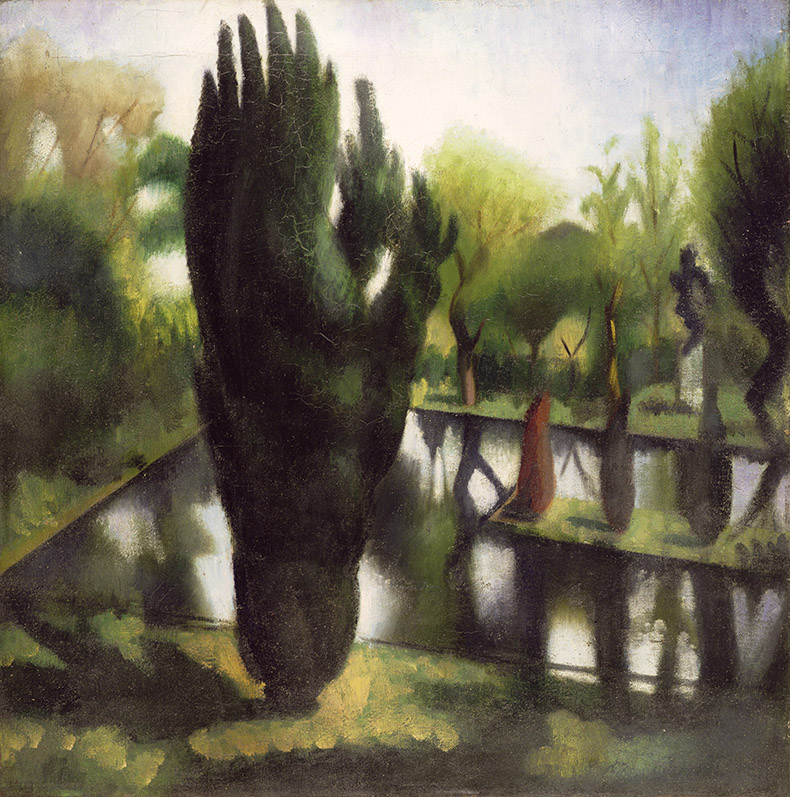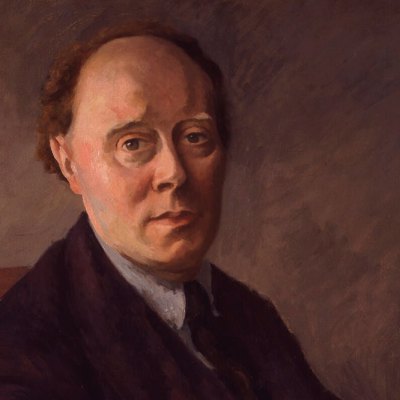From the July/August 2024 issue of Apollo. Preview and subscribe here.
‘How often have I […] leant out gazing, gazing at the moonlight cutting across the gates […] I would creep down and open the old front door and wander out, like a ghost into the silent world and watch the white flowers bathed in a still more luminous white light’. There is in ‘Gardening Bohemia’ a visual match to these words written by Ottoline Morrell about Garsington Manor in Oxfordshire. An embroidery made by a visitor in 1923 named Marian Stoll depicts the auburn-haired Morrell standing in her moonlit Italianate garden, a few ripples on the pool in the foreground the only sign of movement. The dreamlike image echoes an impression left on Virginia Woolf some years earlier when mutual friends had recounted their visits: ‘You are becoming almost too mythical to be believed in any longer,’ she wrote to Morrell. ‘I catch scraps of you and the garden and keep you going in my mind.’ For Stoll and Woolf as for others, then, Morrell’s fascination was bound up with the theatrical garden she created at Garsington.
Morrell and Woolf are joined by Vanessa Bell and Vita Sackville-West at this small yet compelling exhibition proffering bohemia’s answer to the idea of ‘Her Indoors’. Of course, none of these women was of a class to be tied to the kitchen sink when they were indoors; but their relationship to their exterior worlds, the exhibition argues – at Garsington, Monk’s House, Charleston and Sissinghurst – was a significant if not essential part of their creative freedoms and identities.
View into a Garden (1926), Vanessa Bell. Bolton Library and Museum Service; photo: © Bolton Council

Bell moved into Charleston with her lover Duncan Grant in October 1916. Leonard and Virginia Woolf, her sister, had found the Sussex farmhouse for them, Virginia writing to Bell: ‘It has a charming garden, with a pond, & fruit trees, & vegetables, all now rather wild, but you could make it lovely.’ While Roger Fry drew up designs for the garden, Bell lost no time in painting it – The Pond at Charleston (c. 1916) is rendered in simplified forms and swathes of late-summer colour. Hanging next to it is a painting on the same subject around three years later, this time the view from an upstairs window of the house; with a colourful sill of objects and a floral red curtain framing the scene, we get a hint of the celebrated interiors Bell, Grant and friends would make there in the years to come. Cut flowers from the garden (red-hot pokers a favourite) found their way into many of the pair’s paintings, melting the boundary between indoors and out. In View into a Garden (1926) – on the cover of a slim but delightful catalogue by the exhibition’s curator, Claudia Tobin – Bell plays with this idea of a space where the outside is in, the inside out, creating a sort of mirror image.
That view painted from Bell and Grant’s studio has its literary counterpart a cycle-ride away at Monk’s House, bought by the Woolfs in 1919. ‘The point of it is the garden,’ Virginia wrote to a friend. ‘This is going to be the pride of our hearts.’ For much of her time there, she wrote from a shed on the edge of the orchard, where in ‘appling’ season she could hear the thump of fruit falling from the trees. Morrell’s copy of A Room of One’s Own (1929) is included among several first editions of Woolf’s books here; the exhibition invites us to view these gardens as ‘rooms of their own’, and this is most obviously true in Woolf’s case. She cherished days of ‘no talking’, of being able to ‘smell a red rose […] gently surge across the lawn […] light a cigarette, take my writing board on my knee; and let myself down, like a diver, very cautiously into the last sentence I wrote yesterday.’ While Leonard was the more active gardener, Virginia found it therapeutic to work among the flowerbeds, emerging after an evening’s weeding ‘with chocolate earth in our nails’. It wasn’t enough, in the end. Tobin reminds us that the very last sentence in Woolf’s diary before her death in 1941 reads: ‘L. is doing the rhododendrons.’
When the Woolfs moved to Monk’s House, Virginia had asked her friend and some-time lover Sackville-West for advice. ‘You can’t recreate Versailles on a quarter-acre of Sussex,’ came the response. Sackville-West is, of course, the horticultural expert among the women of ‘Gardening Bohemia’ – signalled here by a display of her initialled gardening tools (and a bronze sculpture of her formidable-looking hand). If war cast a shadow over all these gardens, it had its most direct effect on Sissinghurst in Kent. Here among selections of Sackville-West’s books and poems are jottings for her ‘Country Notes’ column, which she continued through the war. In autumn 1938, with conflict (almost literally) on the horizon, she records digging trenches in the fruit-laden orchard. Later on, tanks mowed through the woods and the Elizabethan tower in which she wrote was used by soldiers as a look-out.
The Pond at Garsington (1916), Mark Gertler. Leeds Museums and Galleries

Even without war, this being the world of Bloomsbury there were snakes in paradise – or daggers among the dahlias. The exhibition only hints at how Morrell’s boundless generosity was repaid with malicious gossip (Lytton Strachey among the worst offenders) or unflattering literary portraits. After a visit in June 1923, Woolf derided Morrell’s kindness in hosting a ‘shabby embroideress’ as a typically Ottoline ‘horror’ (she was in fact referring to Stoll, maker of the luminous embroidery displayed here). Morrell was clearly in awe of Woolf, as witnessed by the many photographs she took of her at Garsington. Morrell emerges as a Warholian figure behind the camera, unsure of herself among the luminaries she gathered about her yet leaning into her eccentricity. ‘Gardening Bohemia’ repositions Morrell as an artist in her own right, and perhaps that’s fair; what should never be understated is her role as a patron. She and her husband, Philip, gave shelter to several conscientious objectors during the First World War, many of whom were artists (and many of whom feigned illness rather than so much as chop a piece of firewood). Mark Gertler’s The Pond at Garsington (1916), the stand-out work in this section, was painted during his lengthy stay with them – as was his masterpiece, Merry-Go-Round (1916).
Of the four gardens represented here, Garsington is the only one not open to the public – all the more reason to get a small glimpse of it in this exhibition, along with Lady Ottoline’s highly coloured Russian boots. I only hope she gardened in them.
Summer in the Garden (1911), Roger Fry. Photo: © Philip Mould & Company

‘Gardening Bohemia: Bloomsbury Women Outdoors’ is at the Garden Museum, London, until 29 September.
From the July/August 2024 issue of Apollo. Preview and subscribe here.



